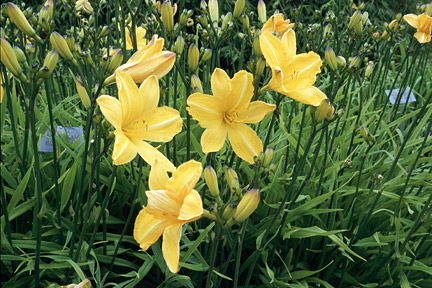
It’s great to attend a garden talk and be surprised. That’s what Ellen Zachos did for me at Seattle’s Northwest Flower and Garden Show. Ellen is an author whose books include Backyard Foraging. Her show presentation covered a huge selection of garden plants that blend both ornamental and edible attributes. The surprise? Half her picks were already growing in my garden—I just didn’t know how edible they were.
Hosta (Hosta species) – Ellen said the tightly furled outer leaves of established hosta can be harvested when around eight inches tall. “Then as the inner leaves unfurl and spread outward,” she noted, “they will hide the cut leaves below.”
Daylilies (Hemerocallis species) – I knew the flower buds taste like oniony green beans when stir-fried. But I had no idea the tubers could also be roasted. Ellen suggested harvesting them when you’re dividing your daylilies.
Oregon grape (Mahonia aquifolium) –Ellen said the handsome blue berries are high in natural pectin, which makes them a great candidate for jams and jellies. And cocktails. Ellen’s upcoming book, The Wildcrafted Cocktail, is all about creating mixed drinks from what you can gather in your greenhouse and garden.
Ostrich fern (Matteucia struthiopteris) – I grow this fern, but also several other large ones—all without tags. Ellen said the flavorful ostrich fern fiddleheads will have three identifiers. Look for a deep green groove on the inside of the smooth stem. Then the plant itself has a dried base in the shape of a volcano. And last, the fronds will have papery sheaths—nothing furry on the covering.
Wild ginger (Asarum canadense) – This groundcover is so useful in partially shaded areas, but again, I didn’t realize the stolons are edible. Ellen suggested digging up plants, nipping off the outer rhizomes, and replanting. They can be used fresh or dried in a dehydrator. “It’s a complex, spicy flavor,” She noted.
Malabar spinach (Basella alba) – Ellen has convinced me. This highly ornamental vine gets a place in my garden this year. She said, “I grew the red-stemmed Malabar spinach for years before I knew how tasty the leaves were.” Now spinach lovers like me can pick the leaves of this climber as a warm-season substitute for regular cool-season spinach.
Ellen summed up her seminar with this: “Why wouldn’t you want to grow something that’s both pretty and tasty? It’s less work than maintaining two separate gardens.”
I’m all for that.










